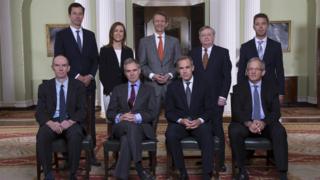Does the Bank of England have a woman problem?
 Image copyright Getty Images
Image copyright Getty Images Take a glance at a photo of the Bank of England’s influential Monetary Policy Committee and its problem is immediately clear.
The nine-strong committee look pretty similar: eight white men and one woman.
This is the body that guides the UK economy. Their monthly votes on interest rates ultimately determine how far our money goes.
Yet they don’t look anything like the people whose lives they have so much influence over.
Women make up half of the UK population, yet just one ninth of the Monetary Policy Committee. There is also not a single black, Asian or minority ethnic group (BAME) member.
In fact, current governor Mark Carney is the 120th in a continuous line of white men to have headed the Bank.
It’s obvious the Bank has a diversity problem.
Last month, the Public Accounts Committee (PAC) said the Bank was some way off its diversity targets for next year “with little evidence the gap is closing quickly enough”.
But in January, the Bank appointed two women: former Virgin Money boss Dame Jayne-Anne Gadhia and Banking Standards Board chair Dame Colette Bowe to its Financial Policy Committee.
The Bank’s chief operating officer Joanna Place also said: “In terms of diversity and inclusion, we have done a lot more than just gender and ethnicity.
“We have a number of staff networks. We have inclusive events. We have a wellbeing policy. We have done a cognitive diversity survey. We have started to look at social mobility,” she added.
Many are hoping that the Bank’s search for a new governor – which kicked off earlier this week – could herald the start of a new era with a female governor at the helm for the first time in its history.
Labour MP Rachel Reeves, who chairs the business select committee and who was an economist at the Bank of England before becoming a politician, said now is the time for the Bank to act: “We’ve had two women prime ministers and yet have had no women chancellors or Bank governors.
“The sad truth is that the Bank has not done enough to recruit, train and promote talented women. More needs to be done to bring forward a generation of women economists who can be considered for the top job.”
‘Self reproducing’
But Wendy Carlin, a professor of economics at University College London, says the problem is not with the Bank of England, but the economics profession itself.
“If you google economists you’ll get a great number of pictures of economists in suits holding up a financial chart. Those impressions are self-reproducing. If people only see men in suits then they don’t think it’s for them,” she says.
Statistics show that women are far less likely than men to study economics, let alone get a job in the sector.Just over a third of undergraduate economics students in the UK are women. The picture is similar in Australia and the US.
Prof Carlin is leading an international project – the CORE project – to change the way economics is taught, with the aim of broadening its appeal.
“We’re being much clearer that economics is about addressing the problems we face. Yes, it’s about financial stability but it’s also about inequality, the environmental future and work.
But, she cautions, work at this academic level will take time to filter through to the real world.
“It’s crucial to widen the pool [of job candidates] as far as possible, but you’ve got to get people into the pool in the first place and that’s what we’re working on,” she says.
Dr Margaret Heffernan, author and the former chief executive of five businesses, says the lack of a women in the sector has become self-fulfilling, that because the profession is dominated by males they tend to “promote and nurture male students”.
“Economics can be very excluding of women, sometimes unintentionally and sometimes intentionally. People with privilege don’t happily give it up,” she says.
Unfair
A recent survey by the American Economic Association of more than 9,200 economists suggests there are also deep-rooted problems. Some 30% of female economists said they felt discriminated against, compared with 12% of men. Women felt they were treated especially unfairly when it came to pay and promotion decisions.
Dr Heffernan says the profession itself should try to make sure it is attracting the widest possible pool of applicants.
One chief executive she spoke to ran a series of different recruitment adverts for a senior position. She found the more junior she made the role sound, the higher the number of female applicants.
“How you word a job will define someone’s right to apply. If you’re not getting the right kind of applicants then describe the job differently and see what happens.”
Room for optimism?
Recruitment firm Sapphire Partners has been asked to carry out the search for the new governor.
The fact it describes itself as “advocates for women in business”, and is run by five female partners, suggests this time there could be room for optimism.
But Dr Heffernan also points out that women in senior positions currently get a lot more scrutiny than men, something that can put them off applying.
“The first woman in any post of visible power knows there’s extra scrutiny that goes with it.
“Everyone wants to know what they’re wearing, what their family and social life is like. Some are ambivalent about that.”
Nonetheless, she says the more common females in power become the less this will happen because it will become a normal rather than extraordinary.
Does she think the next Bank of England governor be a woman?
“I’m cautiously optimistic,” she says.



